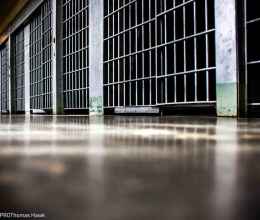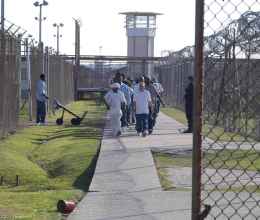Recently, the Department of Justice Inspector General released a report about Oakdale federal prison, and it confirms what we knew when we sued Oakdale seven months ago: Oakdale failed to comply with federal guidance on the coronavirus, and it failed to protect everyone inside the prison, including incarcerated people and staff. Eight prisoners have died from this neglect, and the pandemic still rages inside.
The DOJ report, released on November 17, includes key findings such as:
- Oakdale failed to promptly implement U.S. Bureau of Prisons (BOP) screening guidance.
- Oakdale didn’t fully limit movement inside the prison until after its first positive case on March 21.
- At the beginning of an outbreak in March, Oakdale staff lacked PPE or didn’t understand how to use it properly.
- Oakdale failed to comply with BOP and CDC isolation, quarantine, and PPE guidance.
- Oakdale officials failed to communicate with staff at the beginning of the outbreak, leading them to believe the prison didn’t care about their well-being.
This report, coming as it does from DOJ itself, is incomplete. It does not recognize BOP’s own complicity in this suffering, which is detailed below. But it is a stunning admission that people in the BOP infrastructure at Oakdale have failed to protect the people in their charge.
The story of our client, Brandon Livas, illustrates both BOP’s and the prison’s cruel and inept approach to keeping people safe during the pandemic. After he left Oakdale in May, Brandon was bounced back and forth from home confinement to a halfway house—which also had confirmed cases of coronavirus. He had spent eight months in the prison besieged by the virus, and BOP made his journey home long and difficult.
Brandon is diabetic and has pancreatitis, which puts him at high risk of death from COVID-19. It’s the reason he sought compassionate release from Oakdale; he thought he would be safer outside the prison.
When Brandon was trapped inside on a non-violent, first-time offense, Oakdale had one of BOP’s deadliest, most widespread coronavirus outbreaks. On March 28, 2020, one of the men incarcerated there, Patrick Jones, became the first person in federal custody to die as a result of COVID-19. Two days later, BOP abruptly stopped testing for coronavirus in an effort to hide the extent of the problem. Since then, Oakdale has reported eight coronavirus fatalities. The Warden has been fired. The corrections’ union has sued the prison.
As of November 8, 2020, DOJ’s tally shows 256 people incarcerated and 61 staff members at Oakdale have tested positive for COVID-19. As the virus is taking hold around the country at higher rates than even the spring, we know this problem is not getting better any time soon.
Just two days before that first federal fatality, DOJ had prioritized transfers from Oakdale, and Brandon was a perfect candidate. His lack of criminal history and high susceptibility to COVID-19 made him an obvious choice for transfer. He filed what’s called an administrative request for “compassionate release or home confinement.”
But Oakdale and BOP rank-and-file barely budged—on Brandon or anyone else. Weeks after Barr’s memo, the prison determined 58 people incarcerated there—out of about 1,800—could potentially be released, but only six were actually eligible under its draconian interpretation of BOP’s criteria. Even after reviewing another 90 for home confinement eligibility, Oakdale’s warden said only 15 were potentially eligible.
Because of the prison’s refusal to quickly release vulnerable people, we sued Oakdale on behalf of everyone incarcerated there, trying to get those most at risk out of harm’s way, and reduce the population so distancing would be possible.
Brandon was our lead plaintiff, and he helped us tell the story of the unsafe conditions inside: guards without personal protective equipment, terrible hygiene, lack of cleaning supplies, and men packed together closely in dorms. When we first communicated with him in early April, he was terrified. “There are a bunch of inmates in here with health issues,” he wrote. “It’s no way possible to practice social distancing!” In his area of the prison, a satellite camp, men lived in a barracks-style rooms with about 70 beds per room.
But the court didn’t see it that way. Less than three weeks after we filed the lawsuit, a judge granted BOP’s motion to dismiss the case on jurisdictional grounds. He ruled that forcing BOP to release people would usurp the agency’s discretionary authority to designate and classify their detention. It would make him a “super” warden, he wrote, and that was not in his power.
Meanwhile, conditions at Oakdale got worse. People inside continued to get sick and die, while our client’s ordeal continued.
Thanks in part to the pressure our lawsuit helped bring, Brandon was initially released on home confinement. For a few weeks he was able to keep himself safe, help his friends with an oyster-selling business, and spend time with his children. But then BOP suddenly and senselessly ordered him to report to a halfway house that had already seen four cases of coronavirus infection. The roller coaster of arbitrary restrictions and disruptions continued until September 29, when Brandon finally completed his sentence.
Today Brandon is enjoying his freedom and looking forward to his new life despite the pandemic. But thousands of other incarcerated people remain in harm’s way as numbers of COVID-19 cases are again surging across the state.
Although we were not able to prevail against Oakdale’s egregious conditions in court, Brandon’s resilience should motivate all of us to stay in the fight for justice until everyone is afforded the basic human rights and dignity they deserve.






